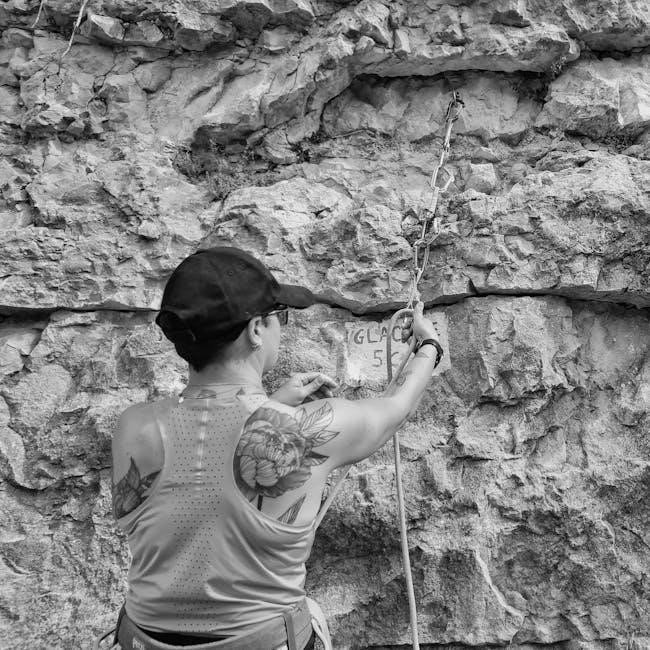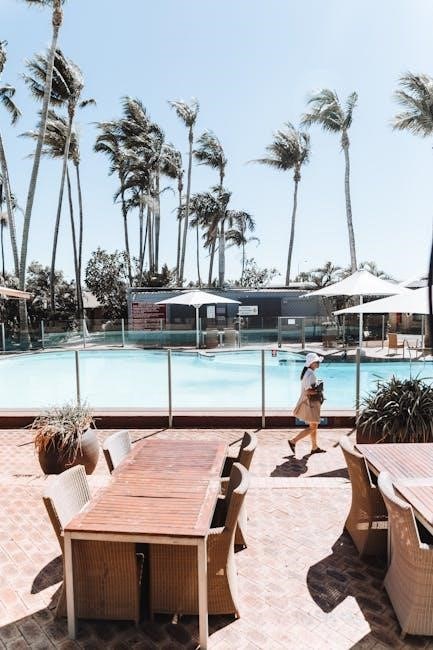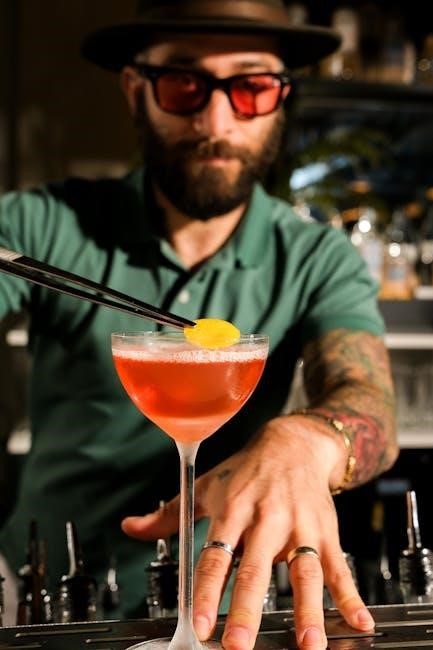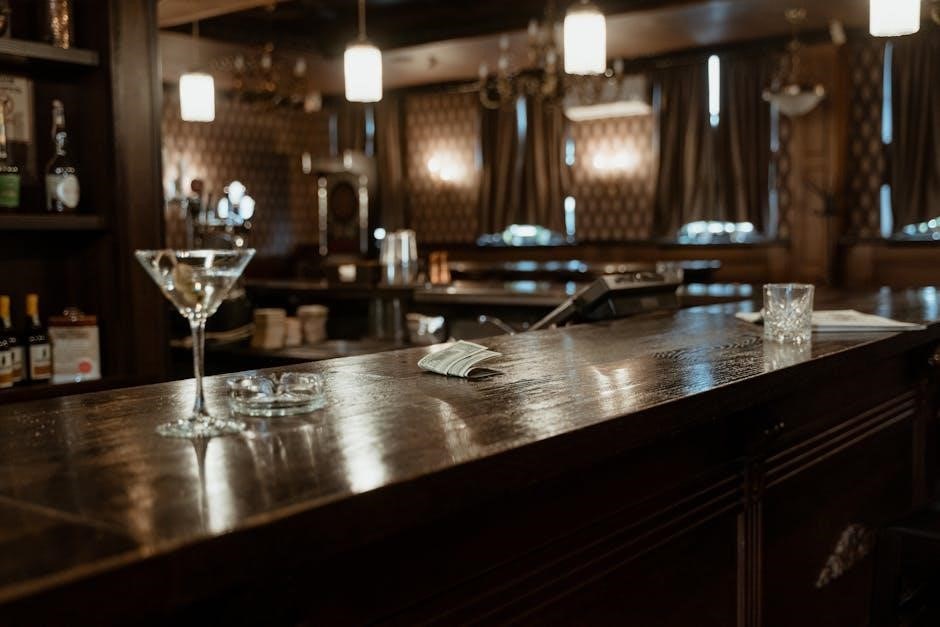The Anarchist Guide to Historic House Museums presents a transformative approach, shifting from traditional models to visitor-centered experiences that challenge conventional narratives and foster collaboration, inspiring new audiences and securing funding.
Overview of the Concept
The Anarchist Guide to Historic House Museums introduces a radical reimagining of historic spaces, emphasizing visitor-centered experiences and collaboration. It challenges traditional museum narratives by embracing inclusivity and creativity, inspired by film, theater, and urban design. The guide advocates for breaking free from rigid interpretations, fostering engagement through shared human experiences. By prioritizing community involvement and immersive storytelling, it transforms historic houses into dynamic, relevant spaces. This approach encourages museums to move beyond static displays, embracing risk and innovation to connect with diverse audiences. The concept underscores the importance of challenging the illusion of authenticity, celebrating the evolving nature of human habitation. Ultimately, it offers a blueprint for sustainability, ensuring historic house museums remain vibrant and meaningful in a rapidly changing world.
Importance of Visitor-Centered Experiences

At the heart of the Anarchist Guide to Historic House Museums is the belief that museums must prioritize visitor-centered experiences to remain relevant. Traditional models often focus on preservation and curatorship, but this approach risks alienating modern audiences who seek engaging, interactive, and meaningful connections. By shifting the focus to visitors, museums can create dynamic, inclusive spaces that foster emotional and intellectual resonance. This involves breaking down barriers between visitors and collections, encouraging participation, and leveraging storytelling to make history relatable. Visitor-centered experiences not only enhance engagement but also ensure that museums remain vital community hubs. The guide emphasizes that empowering visitors to co-create meaning challenges conventional narratives and fosters a sense of ownership, ultimately making historic house museums more accessible and impactful in contemporary society.
The Four Guiding Themes
The four guiding themes—Community, Experience, Habitation, and Shelter—offer a transformative framework for reimagining historic house museums, emphasizing collaboration, engagement, and challenging traditional narratives to foster deeper connections with audiences.
Community: Engaging Surrounding Audiences
The Anarchist Guide to Historic House Museums emphasizes the importance of fostering strong connections with local communities. By breaking down traditional barriers, museums can become vibrant hubs that reflect the needs and stories of their surrounding areas. This approach encourages collaboration, ensuring that the voices of local residents, schools, and businesses are integral to the museum’s programming and exhibits. Rather than being static repositories of the past, historic house museums can evolve into dynamic spaces that celebrate shared histories and contemporary experiences. Engaging the community not only increases relevance but also fosters loyalty and support. This shift challenges the conventional role of museums, transforming them into inclusive platforms where diverse perspectives are valued and heard. By prioritizing community engagement, historic house museums can become more responsive, resilient, and meaningful to the people they serve. This collaborative ethos is central to the anarchist approach, ensuring museums remain vital and connected to their audiences.
Experience: Reimagining Visitor Engagement
The Anarchist Guide to Historic House Museums advocates for a radical shift in how visitors interact with historic spaces. By drawing inspiration from film, theater, and urban design, museums can create immersive, dynamic experiences that break free from static exhibits. This approach challenges traditional narratives, encouraging visitors to engage actively rather than passively observe. The guide suggests using storytelling, interactive installations, and participatory events to bring history to life in ways that resonate with modern audiences. For example, the Morris-Jumel Mansion and Latimer House Museum have successfully implemented such strategies, resulting in increased visitor numbers and press coverage. By reimagining the visitor experience, historic house museums can foster deeper connections and inspire new ways of understanding the past. This emphasis on creativity and interactivity is a cornerstone of the anarchist approach, ensuring museums remain relevant and engaging in a rapidly changing world.
Habitation: Celebrating Human Shelter and Use
The Anarchist Guide to Historic House Museums emphasizes the importance of celebrating human habitation as a core theme. By focusing on the lived experiences within historic spaces, museums can create relatable and engaging narratives. This approach shifts the emphasis from mere preservation to the stories of those who inhabited these spaces, highlighting the everyday lives, struggles, and triumphs of past residents. The guide encourages museums to present historic homes as dynamic, lived-in environments rather than static exhibits. This perspective fosters a deeper emotional connection with visitors, making history more accessible and personal. For instance, the Morris-Jumel Mansion and Latimer House Museum have successfully implemented this concept, showcasing the human side of their histories. By celebrating habitation, museums can redefine their purpose, moving beyond traditional curatorial practices to create meaningful, visitor-centered experiences that resonate with diverse audiences. This theme is central to the anarchist approach, ensuring museums remain relevant and impactful.
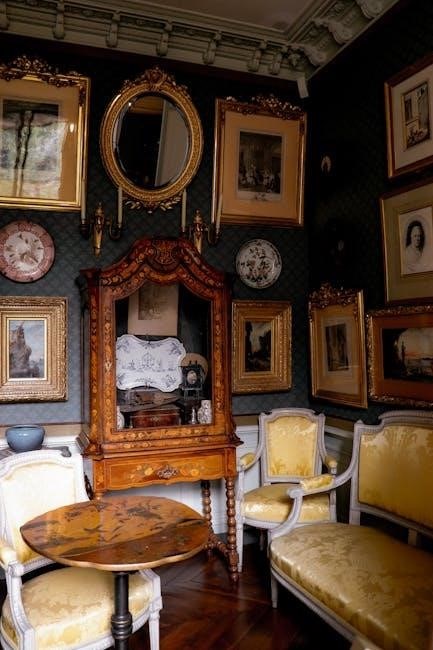
Shelter: Challenging the Illusion of Authenticity
The Anarchist Guide to Historic House Museums critiques the notion of “authenticity” in historic spaces, arguing that it often creates an unattainable ideal. By challenging this illusion, museums can embrace the complexity of history, revealing multiple narratives and interpretations. The guide encourages institutions to move beyond static, curated environments and instead present history as a dynamic, evolving story. This approach acknowledges that historic homes were lived-in spaces, shaped by diverse experiences and perspectives. For example, the Morris-Jumel Mansion has successfully reinterpreted its history to include overlooked voices, offering a more inclusive and nuanced understanding of its past. By breaking free from the constraints of authenticity, museums can foster deeper engagement and encourage visitors to question and explore history critically. This theme is central to the anarchist approach, promoting transparency and honesty in historical interpretation.
Challenges Facing Historic House Museums
Historic house museums face declining audiences, financial constraints, and fierce competition, urging them to adopt bold strategies to remain relevant and engage modern visitors effectively.

Declining Traditional Audiences
Historic house museums are grappling with a significant decline in traditional audiences, driven by shifting cultural preferences and increasing competition from modern entertainment options. As visitor demographics age, museums face challenges in attracting younger, more diverse crowds. This decline threatens the sustainability of these institutions, as reduced attendance directly impacts revenue and community engagement. The rise of digital media and interactive experiences has further heightened expectations, leaving many historic house museums struggling to remain relevant. To combat this, museums must adopt innovative strategies that move beyond static exhibits, embracing immersive and participatory experiences. By reimagining their approach, historic house museums can reconnect with contemporary audiences and ensure their continued vitality in a rapidly evolving cultural landscape.
Financial and Budgetary Constraints
Historic house museums face significant financial and budgetary challenges, exacerbated by declining attendance and shrinking traditional funding sources. Many institutions struggle with limited resources, forcing them to reduce staff, cut programs, and delay critical maintenance. Budgetary pressures are further intensified by the rising costs of preservation and interpretation, making it difficult to sustain operations. These financial constraints often limit the ability to innovate, creating a cycle of stagnation. The Anarchist Guide emphasizes the need for creative solutions, such as leveraging partnerships, crowdsourcing, and earned revenue opportunities, to alleviate these pressures. By embracing collaborative models and rethinking traditional funding strategies, historic house museums can achieve financial stability while remaining true to their mission of preserving and interpreting history.
Core Principles of the Anarchist Approach
The Anarchist Approach emphasizes breaking traditional narratives, fostering collaboration, and prioritizing visitor-centered experiences. It encourages museums to challenge conventional practices and embrace risk-taking to create engaging and inclusive spaces.
Breaking Traditional Museum Narratives
The Anarchist Guide advocates for dismantling rigid, curator-driven narratives in historic house museums. By challenging conventional storytelling, museums can create more dynamic, inclusive experiences that resonate with diverse audiences. This approach encourages museums to move beyond static displays and embrace interactive, immersive storytelling. Rather than focusing solely on the lives of wealthy former occupants, the guide suggests highlighting untold stories of servants, enslaved individuals, and other marginalized groups. This shift fosters a more nuanced understanding of history and makes museums more relevant to contemporary visitors. By breaking free from traditional narratives, museums can engage visitors on a deeper level, sparking curiosity and fostering empathy. This radical reimagining of historical interpretation ensures that museums remain vital and meaningful in a rapidly changing world.
Embracing Collaboration and Risk-Taking
The Anarchist Guide emphasizes the importance of collaboration and risk-taking in redefining historic house museums. By engaging with local communities and involving visitors in the creative process, museums can foster a sense of shared ownership and relevance. This approach encourages museums to step away from rigid, top-down decision-making and instead embrace participatory practices. Risk-taking is celebrated as a means to innovate and experiment with new ideas, such as co-curating exhibits with community groups or incorporating unconventional programming. Collaboration also extends to partnerships with artists, designers, and educators, bringing fresh perspectives to historic spaces. By embracing these principles, museums can break free from stagnation and become dynamic, responsive institutions that thrive on creativity and inclusivity. This collaborative ethos is central to the guide’s vision of museums as living, evolving entities deeply connected to their communities.
Case Studies and Successful Implementations

The Morris-Jumel Mansion and Latimer House Museum exemplify the guide’s principles, with increased visitor engagement, press coverage, and funding, demonstrating the transformative impact of anarchist-inspired approaches in historic house museums.
The Morris-Jumel Mansion: A Model of Success
The Morris-Jumel Mansion in New York City stands as a prime example of the Anarchist Guide to Historic House Museums in action. By embracing the guide’s principles, the mansion has successfully reimagined its approach to visitor engagement, leading to a significant increase in first-time visitors, media attention, and funding. The mansion’s events, inspired by the guide, have fostered a deeper connection with its surrounding community, breaking away from traditional museum norms. This shift has not only enhanced the visitor experience but also positioned the mansion as a dynamic cultural hub. The success of the Morris-Jumel Mansion highlights the potential of anarchist-inspired strategies to revitalize historic house museums, making them more relevant and engaging in contemporary society. Its story serves as a powerful testament to the guide’s transformative impact.
The Latimer House Museum: An Ongoing Experiment
The Latimer House Museum in Queens serves as an ongoing experiment in applying the principles of the Anarchist Guide to Historic House Museums. With funding from a $100,000 grant by the New York Community Trust, the museum is currently designing and evaluating an Anarchist Plan to redefine its role in the community. This initiative aims to break traditional molds by engaging visitors in innovative ways, fostering collaboration, and challenging the illusion of authenticity. The Latimer House Museum is still in the process of implementing these radical changes, making it a dynamic example of how historic house museums can evolve to meet modern demands. Its journey reflects the guide’s emphasis on risk-taking and community-driven approaches, positioning it as a living laboratory for anarchist-inspired museum practices.

Practical Strategies for Implementation
Reimagine exhibits using film, theater, and urban design to create immersive experiences, while fostering community collaboration and risk-taking to ensure dynamic, visitor-centered engagement in historic spaces.

How to Reimagine Exhibits and Programs
Reimagining exhibits and programs involves shifting from static displays to dynamic, interactive experiences that prioritize visitor engagement. This can be achieved by incorporating storytelling, multimedia, and hands-on activities that reflect the lived experiences of the spaces. Collaboration with local communities and artists ensures authenticity and relevance, while embracing risk-taking encourages innovative programming. For instance, historic house museums can integrate film screenings, live performances, or urban design elements to create immersive environments. By breaking away from traditional curatorial approaches, museums can foster deeper connections with their audiences. The Morris-Jumel Mansion exemplifies this approach, having successfully increased visitor engagement and funding through such strategies. Ultimately, reimagining exhibits and programs requires a commitment to continuous evolution and a willingness to challenge conventional norms in favor of visitor-centered experiences.
Leveraging Film, Theater, and Urban Design
Integrating film, theater, and urban design into historic house museums creates immersive and engaging experiences that challenge traditional interpretations. Film screenings can bring historic narratives to life, while theatrical performances can animate the spaces with storytelling. Urban design elements, such as interactive installations or public art, can transform museums into dynamic community hubs. These approaches encourage visitors to connect emotionally and intellectually with the spaces, fostering a deeper understanding of history. By embracing these creative mediums, museums can break free from static exhibits and offer fresh, innovative programming. This strategy not only attracts new audiences but also redefines the role of historic houses as vibrant, living spaces. The fusion of art and history in this way aligns with the anarchist guide’s emphasis on collaboration and risk-taking, ensuring museums remain relevant and impactful in modern times.

The Impact of the Anarchist Guide
The Anarchist Guide has significantly influenced the museum field, inspiring transformative changes, increasing visitor engagement, and securing funding. Its innovative strategies have redefined historic house museums’ relevance and appeal.
Reception and Influence in the Museum Field
The Anarchist Guide to Historic House Museums has garnered significant attention for its bold, rule-breaking approach, inspiring museums to adopt innovative strategies. Its emphasis on visitor-centered experiences and community engagement has resonated widely, leading to increased funding and visitor numbers at sites like the Morris-Jumel Mansion. The guide’s influence extends beyond historic house museums, challenging traditional narratives across the museum field. By advocating for collaboration and risk-taking, it has sparked a movement toward more inclusive and dynamic cultural institutions. The book’s success is evident in its multiple printings and its recognition as a key resource for reimagining historic spaces. Its impact continues to grow, encouraging museums to embrace transformative change and connect more deeply with their audiences.
Inspiring New Audiences and Funding Opportunities
The Anarchist Guide to Historic House Museums has proven to be a catalyst for attracting new audiences and securing funding. By prioritizing visitor-centered experiences and community collaboration, historic house museums have seen significant increases in first-time visitors, media attention, and financial support. For instance, the Morris-Jumel Mansion experienced a surge in attendance and revenue after implementing the guide’s principles. Similarly, the Latimer House Museum received a $100,000 grant to develop an Anarchist Plan, demonstrating the guide’s potential to unlock new funding streams. These successes highlight how breaking traditional molds and embracing innovative strategies can revitalize historic spaces, making them more relevant and appealing to diverse audiences while ensuring long-term sustainability.

Looking to the Future
The Anarchist Guide to Historic House Museums inspires a future where historic spaces evolve into dynamic, community-driven hubs, blending innovative design and storytelling to ensure long-term relevance and sustainability.
Expanding the Role of Historic House Museums
Historic house museums are evolving beyond static preservation, embracing dynamic roles as vibrant community hubs. The Anarchist Guide advocates for reimagining these spaces to foster creativity, dialogue, and shared experiences, moving beyond traditional stewardship. By integrating film, theater, and urban design, museums can create immersive, engaging environments that resonate with diverse audiences. This shift encourages museums to collaborate with visitors, challenging the illusion of authenticity and fostering a more inclusive understanding of history. Successful examples, like the Morris-Jumel Mansion and the Latimer House Museum, demonstrate how bold, community-driven approaches can revitalize historic sites, attracting new visitors and securing funding. The future of historic house museums lies in their ability to adapt, becoming spaces where the past and present intersect to inspire and empower communities.
Ensuring Sustainability and Relevance
Historic house museums face significant challenges, including declining audiences and financial constraints, necessitating innovative strategies to remain relevant. The Anarchist Guide emphasizes the importance of embracing risk and collaboration to secure long-term sustainability. By prioritizing visitor-centered experiences and community engagement, museums can foster deeper connections and attract diverse audiences. The guide encourages museums to move beyond traditional preservation, integrating film, theater, and urban design to create dynamic, immersive environments. Successful implementations, such as those at the Morris-Jumel Mansion, demonstrate how bold approaches can increase visitor numbers and funding. Sustainability also requires museums to challenge the illusion of authenticity, embracing the evolving nature of history and human experience. By adapting to modern demands and fostering inclusivity, historic house museums can ensure their continued relevance and vitality in an ever-changing cultural landscape.

Conclusion
The Anarchist Guide to Historic House Museums challenges traditional narratives, advocating for inclusive, visitor-centered experiences that reimagine historic spaces and foster community engagement, ensuring a vibrant future for these cultural treasures.
Reflecting on the Significance of the Anarchist Guide
The Anarchist Guide to Historic House Museums has emerged as a transformative force, challenging traditional museum narratives and advocating for visitor-centered, inclusive experiences. By emphasizing collaboration, risk-taking, and community engagement, it reimagines historic spaces as dynamic hubs for shared human experiences. The guide’s emphasis on breaking conventional practices has inspired museums to adopt bold strategies, such as immersive exhibits and interdisciplinary collaborations, ensuring their relevance in a rapidly changing cultural landscape. Its impact is evident in successful case studies like the Morris-Jumel Mansion and the Latimer House Museum, where innovative approaches have boosted engagement and funding. Ultimately, the guide’s significance lies in its ability to empower historic house museums to evolve, fostering a more democratic and vibrant understanding of history while ensuring their sustainability for future generations.

